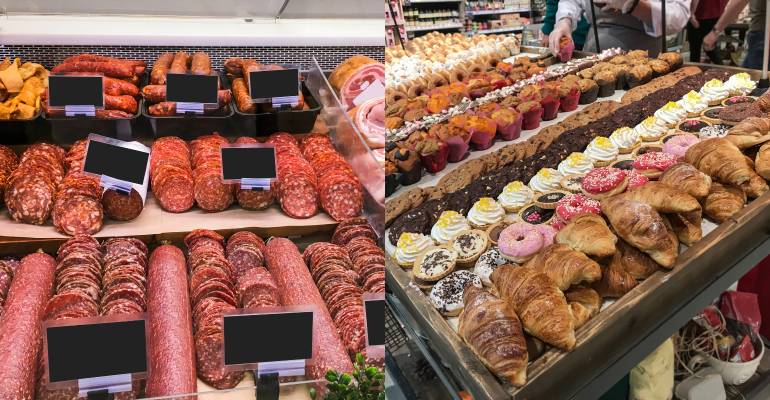Retailers can drive incremental sales in the deli, dairy and bakery departments by encouraging premium purchases and promoting freshness, convenience and value.
That was among the messages that Anne-Marie Roerink, founder of 210 Analytics, presented during an educational session at the recent International Dairy, Deli, Bakery Association Show in Anaheim, Calif. She cited examples from around the world of creative supermarket promotions that highlight these attributes, from ringing a bell to signal freshly baked bread at Lowe’s in the Carolinas to using QR codes to download lists of items on sale at a supermarket in Australia.
Other promotional strategies that supermarkets are deploying to drive sales in their bakery and deli prepared foods departments sales mimic those of their restaurant competitors. These include department-specific loyalty programs, such as buy 10 salads, get one free in the deli. These types of promotions can help generate more frequent shopping trips, Roerink said.
“Driving frequency is extremely important, because at the end of the day, it is so much harder to get someone who has never engaged with your product, or your department, than it is to drive up the frequency of someone who is engaged with you,” she said. “It’s all about figuring out how to get people to buy that one extra item.”
Some supermarkets are also seeking to become known for offering certain prepared foods on certain days, such as Rouses Markets in Louisiana, which promotes barbecue ribs on Fridays.
“We’re seeing a lot of creativity relative to time variations in promotions,” said Roerink. “Restaurants tend to be really known for a certain meal, so if you can be known for something, that can be important, especially as it ties back to daily specials.”
Another example is a “donut happy hour” when store-made donuts are offered at a discount late in the day.
“How smart is that? Because you have to toss them out at the end of the evening anyway,” Roerink said.
Other promotional ideas included:
• Compare-and-save messaging
Amid the current climate of inflation and economic uncertainty, some retailers are seeking to promote the affordability of their offerings relative to the competition.
At Sainsbury’s in the U.K., for example, the retailer displays signs showing the price per pound of some of its meats matching the prices of discounter Aldi.
Wegmans Food Markets, meanwhile, seeks to send the message that cooking at home is more affordable by highlighting the full cost of home-cooked meals, such as hamburger dinners for $2 per person or tilapia dinners for $4 per person.
“What a great way to show that cost savings,” said Roerink.
Consumers might not take the time to calculate the cost of their groceries in those terms, which makes it easy for them to compare the cost of dining at restaurants, she said.
• Create more special occasions
The deli and bakery, with their party platters and custom cakes, have always been destinations for people hosting celebratory gatherings, but there may be opportunities to drive even more sales around special occasions. These are also the types of premium purchases that consumers are inclined to spend more money on, Roerink said.
She cited as an example the potential to drive more at-home dining for some occasions that tend to be celebrated in restaurants, such as Valentine’s Day. Carrefour in France for example, promotes the idea of a romantic dinner at home with merchandising that includes a special dinner menu, roses and heart-shaped balloons.
That concept could even be extended to promoting a “date night” dinner at home, Roerink suggested.
“Make it easy for people to celebrate,” she said.
Retailers can also look for other ways to promote occasions—creating excitement around cultural events such as a new Xbox release, for example, or piggybacking on sports events beyond the typical football tailgate parties, such as World Cup soccer.
“Be creative,” Roerink said. “For national watermelon day, why not create a watermelon shaped cake in the bakery?”
• Treats enhance emotional wellbeing
Verbiage in the bakery department is especially important at a time when consumers are concerned about maintaining both their physical and emotional well-being, Roerink said.
Consider fun signage like some retailers have deployed, such as “Can you use a fudge break?” showing a dad attempting to wrangle two squirming kids, or a case of baked goods under a sign proclaiming that “Sweet dreams are made of treats.”
Offering smaller portions of indulgent items such as these may also be helpful in driving sales of such products, she noted.
• Cross-promote with signage
Cross-promoting products in other departments is a proven vehicle for driving incremental sales, but it can be challenging to execute well, Roerink said, citing the need to physically merchandise products in other departments and maintain the displays.
One way around that is simply by using signage or coupons to drive consumers to different departments—promoting burgers in both the bread and condiment aisle, for example, or suggesting rotisserie chicken to people shopping for salads.
• Freshness sells
Freshness is perhaps the most important aspect of the dairy/deli/bakery department, she said, citing the Lowes Foods example. The Winston-Salem, N.C.-based retailer announced freshly baked bread with the ringing of a bell, which cues workers throughout the store to shout, “fresh bread!”
Roerink added that retailers should reinforce their freshness claims with specific messaging that also highlights their expertise, such as “made by our expert chefs” or “by our professional cake decorators.”
• Show your sustainability
Retailers seeking to sell through expiring product can also reinforce the message that they are preventing food from being wasted, Roerink suggested.
Safeway Canada, for example, suggests ways that customers can use bread that is getting stale, while a retailer in Holland places a sticker on reduced-price items that says, “together we waste less.”
“What a way to change the dialog,” Roerink said.





